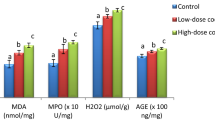Opium tincture (OT) is one of the common drugs in the treatment of addiction. However, the metabolism of its chemical compounds (e.g. morphine) may be side effects on liver. The present study aimed to the effect of OT on liver tissue in animal model and also, evaluated outcome of dose-depended of chicory extract on hepatotoxicity. In the present study, 70Wistar rats were divided into 10 groups: 1. Control, 2. Vehicle, 3. Therapeutics groups (T1: 0.2 mL of OT, T2: 0.15 mL of OT, T3: 0.1 mL of OT, TC1: 0.15 mL of OT and 100 mg/kg of chicory, TC2: 0.15 mL of OT and 250 mg/kg of chicory, TC3: 0.15 mL of OT and 400 mg/kg chicory, CT1: 0.2 mL of OT and 250 mg/kg of chicory, CT2: 0.1 mL of OT and 250 mg/kg of chicory). The enzymes level of liver were measured. Also, the histopathological analysis were performed. The evaluation of liver enzymes level showed a significant difference between T1 and vehicle groups (P < 0.05). However, there was no significant difference between groups received to chicory compared with vehicle group. Also, the mean of hepatocytes diameter and number of Kupffer cells significantly increase in T1 and T2 groups compared with vehicle group (P < 0.05). Administration of high concentration of OT may cause hepatotoxicity and it seems that 0.1 mL concentration of OT (2 mg of morphine) may be suitable in addiction withdrawal. Also, the chicory extract in a dose-dependent manner is useful in reduction of hepatotoxicity.



Similar content being viewed by others
References
F. Tabassomi, M. Zarghami, M. R. Shiran, et al., Addict. Dis, 35, 8 – 14 (2016).
M. G. Carlin, J. R. Dean, and J. M. Ames, Front. Chem., 1, 737 – 739 (2020).
M. Khansari, M. Sohrabi, and F. Zamani, MEJDD, 1, 54 – 61 (2013).
M. Moghimian, S. Aalami, S. H. Abtahi-Evari, and M. Soltani, Physiol. Pharmacol., 2, 109 – 117 (2018).
Z. A. Mehrjerdi and M. Zarghami, Hepat. Mon., 4, 12 – 31 (2013).
S. M. Mohafrash and A. T. H. Mossa, ESPR, 27, 72 – 82 (2020).
D. David and B. Sears, Agric. Nat. Resour., 4, 190 – 191 (2007).
M. A. Farhangi, A. Z. Javid, and P. Dehghan, Prim. Care Diabetes, 4, 265 – 271 (2016).
H. A. Aisa, X. I. Xin, and D. Tang, Chin. Herb. Med., 3, 224 – 236 (2020).
Y. S. El-Sayed, M. A. Lebda, M. Hassinin, and S. A. Neoman, PloS One, 3, 34 – 51 (2015).
O. A. Almazroo, M. K. Miah, and R. Venkataramanan, Clin. Liver Dis., 1, 1 – 20 (2017).
M. Ebrahiminia, F. Esmaeili, and L. Shabani, J. Ethnopharmacol., 10, 11 – 22 (2020).
A. Mushtaq, M. Ahmad, and Q. Jabeen, J. Curr. Pharmaceut. Res., 5, 25 – 30 (2013).
M. R. Salahshoor, S. Roshankhah, P. Hosseni, and C. Jalili, Chin. Med., 13, 59 – 108 (2018).
T. Peirouvi, Y. Mirbaha, A. Fathi-Azarbayjani, and A. Shalizar Jalali, Int. J. High Risk Behav. Addict., 3, 21 – 28 (2020).
C. Jalili, S. Ahmadi, S. Roshankhah, and M. Salahshoor, Int. J. Reprod. Biomed., 2, 95 – 101 (2016).
J. Mohamed, A. N. Nafizah, A. Zariyantey, and S. Budin, Sultan Qaboos Univ. Med. J., 2, 134 – 151 (2016).
K. M. M. Hasan, N. Tamanna, and M. A. Haque, Food Sci. Hum. Wellness, 1, 77 – 82 (2018).
L. Song, Adv. Clin. Chem., 82, 1 – 46 (2017).
S. Sefidkerdar and S. Hosseini, JArUMS, 2, 140 – 153 (2018).
H. Zhu, Z. Wang, Y. Wu, et al., Int. J. Biol. Macromol., 128, 363 – 375 (2019).
S. Atici, I. Cinel, L. Cinel, et al., Oral U. J. Biosci., 2, 245 – 252 (2005).
A. Ghaffari, M. Rafraf, R. Navekar, et al., Int. J. Vitam. Nutr Res., 4, 10 – 24 (2019).
W. Watjen, G. Michels, B. Steffan, et al., Nutr. J, 1, 525 – 531 (2005).
Author information
Authors and Affiliations
Corresponding author
Rights and permissions
Springer Nature or its licensor (e.g. a society or other partner) holds exclusive rights to this article under a publishing agreement with the author(s) or other rightsholder(s); author self-archiving of the accepted manuscript version of this article is solely governed by the terms of such publishing agreement and applicable law.
About this article
Cite this article
Seyedebrahimi, R., Azimzadeh, M., Ababzadeh, S. et al. Histopathological and Enzymological Evaluation of Opium Tincture and Protective Effects of Chicory Extract on Liver Structure in Adult Male Rats. Pharm Chem J 57, 395–400 (2023). https://doi.org/10.1007/s11094-023-02896-z
Received:
Published:
Issue Date:
DOI: https://doi.org/10.1007/s11094-023-02896-z




